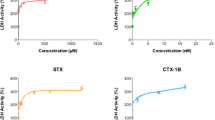Abstract
The non-protein amino acid (NPAA) ß-methylamino-l-alanine (BMAA) is produced by a diverse range of cyanobacteria, diatoms and dinoflagellates, and is present in both aquatic and terrestrial ecosystems globally. Exposure to BMAA has been implicated in the development of neurodegenerative diseases including amyotrophic lateral sclerosis (ALS), Alzheimer’s disease (AD) and Parkinson’s disease (PD). BMAA is often found in nature along with its structural isomers 2,4-diaminobutyric acid (2,4-DAB) and aminoethylglycine (AEG); however, the toxicity of these NPAAs in combination has not been examined. We have previously demonstrated that BMAA induces endoplasmic reticulum (ER) stress and increases caspase and cathepsin activity in human neuroblastoma cells (SH-SY5Y), effects consistent with proteotoxic stress due to disturbances in protein synthesis, folding or turnover. The current study investigates whether 2,4-DAB and AEG share a similar mechanism of toxicity to BMAA, and if simultaneous exposure of cells to BMAA and its isomers results in increased toxicity in vitro. We show that a 48-h treatment with both 500 μM BMAA and 2,4-DAB decreases cell viability in vitro whereas AEG was not cytotoxic under the same conditions. Treatment of SH-SY5Y cells with 2,4-DAB did not increase expression of ER stress markers. Combined treatment of cells with BMAA and 2,4-DAB resulted in increased caspase activity and increased apoptosis above that of BMAA or 2,4-DAB on their own. These results suggest that 2,4-DAB does not share the same mechanism of toxicity as BMAA but the presence of 2,4-DAB increases the toxicity of BMAA to human cells in vitro.






Similar content being viewed by others
References
Al-Sammak MA, Hoagland KD, Cassada D, Snow DD (2014) Co-occurrence of the cyanotoxins BMAA, DABA and anatoxin-a in Nebraska reservoirs, fish, and aquatic plants. Toxins (Basel) 6(2):488–508. doi:10.3390/toxins6020488
Andersen CL, Jensen JL, Ørntoft TF (2004) Normalization of real-time quantitative reverse transcription-PCR data: a model-based variance estimation approach to identify genes suited for normalization, applied to bladder and colon cancer data sets. Cancer Res 64:5245–5250. doi:10.1158/0008-5472.CAN-04-0496
Banack SA, Murch SJ (2009) Multiple neurotoxic items in the Chamorro diet link BMAA with ALS/PDC. Amyotroph Lateral Scler 10(Suppl 2):34–40. doi:10.3109/17482960903278451
Banack SA, Caller T, Henegan P et al (2015) Detection of cyanotoxins, β-N-methylamino-L-alanine and microcystins, from a lake surrounded by cases of amyotrophic lateral sclerosis. Toxins (Basel) 7:322–336. doi:10.3390/toxins7020322
Bradley WG, Borenstein AR, Nelson LM et al (2013) Is exposure to cyanobacteria an environmental risk factor for amyotrophic lateral sclerosis and other neurodegenerative diseases? Amyotroph Lateral Scler Frontotemporal Degener 14:325–333. doi:10.3109/21678421.2012.750364
Chen C-H, Flory W, Koeppe RE (1972) Variation of neurotoxicity of l- and d-2,4-diaminobutyric acid with route of administration. Toxicol Appl Pharmacol 23:334–338. doi:10.1016/0041-008X(72)90194-9
Chiu AS, Gehringer MM, Braidy N et al (2012) Excitotoxic potential of the cyanotoxin β-methyl-amino-L-alanine (BMAA) in primary human neurons. Toxicon 60:1159–1165. doi:10.1016/j.toxicon.2012.07.169
Chiu AS, Gehringer MM, Braidy N et al (2013) Gliotoxicity of the cyanotoxin, β-methyl-amino-L-alanine (BMAA). Sci Rep 3:1482. doi:10.1038/srep01482
Chiu AS, Braidy N, Marçal H et al (2015) Global cellular responses to β-methyl-amino-l-alanine (BMAA) by olfactory ensheathing glial cells (OEC). Toxicon 99:136–145. doi:10.1016/j.toxicon.2015.03.009
Chwieralski CE, Welte T, Bühling F (2006) Cathepsin-regulated apoptosis. Apoptosis 11:143–149. doi:10.1007/s10495-006-3486-y
Cox PA, Banack SA, Murch SJ (2003) Biomagnification of cyanobacterial neurotoxins and neurodegenerative disease among the Chamorro people of Guam. Proc Natl Acad Sci U S A 100:13380–13383. doi:10.1073/pnas.2235808100
Cox PA, Banack SA, Murch SJ et al (2005) Diverse taxa of cyanobacteria produce beta-N-methylamino-L-alanine, a neurotoxic amino acid. Proc Natl Acad Sci U S A 102:5074–5078. doi:10.1073/pnas.0501526102
Cox PA, Richer R, Metcalf JS et al (2009) Cyanobacteria and BMAA exposure from desert dust: a possible link to sporadic ALS among Gulf War veterans. Amyotroph lateral Scler Off Publ World Fed Neurol Res Gr Mot Neuron Dis 10(Suppl 2):109–117. doi:10.3109/17482960903286066
Cox PA, Davis DA, Mash DC et al (2016) Dietary exposure to an environmental toxin triggers neurofibrillary tangles and amyloid deposits in the brain. Proc Biol Sci. doi:10.1098/rspb.2015.2397
Craighead D, Metcalf JS, Banack SA et al (2009) Presence of the neurotoxic amino acids beta-N-methylamino-L-alanine (BMAA) and 2,4-diamino-butyric acid (DAB) in shallow springs from the Gobi Desert. Amyotroph Lateral Scler 10(Suppl 2):96–100. doi:10.3109/17482960903278469
Cullen SP, Martin SJ (2009) Caspase activation pathways: some recent progress. Cell Death Differ 16:935–938. doi:10.1038/cdd.2009.59
Droga-Mazovec G, Bojic L, Petelin A et al (2008) Cysteine cathepsins trigger caspase-dependent cell death through cleavage of bid and antiapoptotic Bcl-2 homologues. J Biol Chem 283:19140–19150. doi:10.1074/jbc.M802513200
Dunlop RA, Cox PA, Banack SA, Rodgers KJ (2013) The non-protein amino acid BMAA is misincorporated into human proteins in place of l-serine causing protein misfolding and aggregation. PLoS One 8:e75376. doi:10.1371/journal.pone.0075376
Faassen EJ, Gillissen F, Zweers HAJ, Lürling M (2009) Determination of the neurotoxins BMAA (beta-N-methylamino-L-alanine) and DAB (alpha-,gamma-diaminobutyric acid) by LC-MSMS in Dutch urban waters with cyanobacterial blooms. Amyotroph Lateral Scler 10(Suppl 2):79–84. doi:10.3109/17482960903272967
Gonzalez R, Tarloff J (2001) Evaluation of hepatic subcellular fractions for Alamar blue and MTT reductase activity. Toxicol Vitr 15:257–259. doi:10.1016/S0887-2333(01)00014-5
Ho DV, Chan JY (2015) Induction of Herpud1 expression by ER stress is regulated by Nrf1. FEBS Lett 589:615–620. doi:10.1016/j.febslet.2015.01.026
Huang C-H, Chu Y-R, Ye Y, Chen X (2014) Role of HERP and a HERP-related protein in HRD1-dependent protein degradation at the endoplasmic reticulum. J Biol Chem 289:4444–4454. doi:10.1074/jbc.M113.519561
Jiang L, Aigret B, De Borggraeve WM et al (2012) Selective LC-MS/MS method for the identification of BMAA from its isomers in biological samples. Anal Bioanal Chem 403:1719–1730. doi:10.1007/s00216-012-5966-y
Jiang L, Eriksson J, Lage S et al (2014) Diatoms: a novel source for the neurotoxin BMAA in aquatic environments. PLoS One 9:e84578. doi:10.1371/journal.pone.0084578
Johnston GA, Twitchin B (1977) Stereospecificity of 2,4-diaminobutyric acid with respect to inhibition of 4-aminobutyric acid uptake and binding. Br J Pharmacol 59:218–219
Jonasson S, Eriksson J, Berntzon L et al (2010) Transfer of a cyanobacterial neurotoxin within a temperate aquatic ecosystem suggests pathways for human exposure. Proc Natl Acad Sci U S A 107:9252–9257. doi:10.1073/pnas.0914417107
Kikuchi H, Yamada T, Furuya H et al (2003) Involvement of cathepsin B in the motor neuron degeneration of amyotrophic lateral sclerosis. Acta Neuropathol 105:462–468. doi:10.1007/s00401-002-0667-9
Kim S-E, Mori R, Komatsu T et al (2015) Upregulation of cytochrome c oxidase subunit 6b1 (Cox6b1) and formation of mitochondrial supercomplexes: implication of Cox6b1 in the effect of calorie restriction. Age (Dordr) 37:9787. doi:10.1007/s11357-015-9787-8
Kritis A, Stamoula E, Paniskaki K, Vavilis T (2015) Researching glutamate–induced cytotoxicity in different cell lines: a comparative/collective analysis/study. Front Cell Neurosci 9:1–18. doi:10.3389/fncel.2015.00091
Lage S, Costa PR, Moita T et al (2014) BMAA in shellfish from two Portuguese transitional water bodies suggests the marine dinoflagellate Gymnodinium catenatum as a potential BMAA source. Aquat Toxicol 152C:131–138. doi:10.1016/j.aquatox.2014.03.029
Li M, Ona VO, Guégan C et al (2000) Functional role of caspase-1 and caspase-3 in an ALS transgenic mouse model. Science 288:335–339
Livak KJ, Schmittgen TD (2001) Analysis of relative gene expression data using real-time quantitative PCR and the 2-delta detla CT method. Methods 25(4):402–408
Main BJ, Dunlop RA, Rodgers KJ (2015) The use of L-serine to prevent β-methylamino-L-alanine (BMAA)-induced proteotoxic stress in vitro. Toxicon 24:1639–1641. doi:10.1016/j.toxicon.2015.11.003
Masseret E, Banack S, Boumédiène F et al (2013) Dietary BMAA exposure in an amyotrophic lateral sclerosis cluster from southern France. PLoS One 8:e83406. doi:10.1371/journal.pone.0083406
Merel S, Walker D, Chicana R et al (2013) State of knowledge and concerns on cyanobacterial blooms and cyanotoxins. Environ Int 59:303–327. doi:10.1016/j.envint.2013.06.013
Murch SJ, Cox PA, Banack SA (2004) A mechanism for slow release of biomagnified cyanobacterial neurotoxins and neurodegenerative disease in Guam. Proc Natl Acad Sci U S A 101:12228–12231. doi:10.1073/pnas.0404926101
Nishitoh H (2012) CHOP is a multifunctional transcription factor in the ER stress response. J Biochem 151:217–219. doi:10.1093/jb/mvr143
O’Neal RM, Chen C-H, Reynolds CS et al (1968) The “neurotoxicity” of l-2,4-diaminobutyric acid. Biochem J 106:699–706. doi:10.1042/bj1060699
Okle O, Stemmer K, Deschl U, Dietrich DR (2012) L-BMAA induced ER stress and enhanced caspase 12 cleavage in human neuroblastoma SH-SY5Y cells at low nonexcitotoxic concentrations. Toxicol Sci 131:217–224. doi:10.1093/toxsci/kfs291
Olivari S, Molinari M (2007) Glycoprotein folding and the role of EDEM1, EDEM2 and EDEM3 in degradation of folding-defective glycoproteins. FEBS Lett 581:3658–3664. doi:10.1016/j.febslet.2007.04.070
Ouyang Q, Nakayama T, Baytas O et al (2016) Mutations in mitochondrial enzyme GPT2 cause metabolic dysfunction and neurological disease with developmental and progressive features. Proc Natl Acad Sci U S A 113:E5598–E5607. doi:10.1073/pnas.1609221113
Pilbeam DJ, Bell EA (1979) Free amino acids in crotalaria seeds. Phytochemistry 18:973–985. doi:10.1016/S0031-9422(00)91460-2
Polsky FI, Nunn PB, Bell E (1972) Distribution and toxicity of alpha- amino-beta-methylaminopropionic acid. Fed Proc 31:1473–1475
Rashid H-O, Yadav RK, Kim H-R, Chae H-J (2015) ER stress: autophagy induction, inhibition and selection. Autophagy 11:1956–1977. doi:10.1080/15548627.2015.1091141
Rutkowski DT, Kaufman RJ (2004) A trip to the ER: coping with stress. Trends Cell Biol 14:20–28. doi:10.1016/j.tcb.2003.11.001
Salgado MC, Metón I, Anemaet IG, Baanante IV (2014) Activating transcription factor 4 mediates up-regulation of alanine aminotransferase 2 gene expression under metabolic stress. Biochim Biophys Acta 1839:288–296. doi:10.1016/j.bbagrm.2014.01.005
Sánchez-Alcázar JA, Ault JG, Khodjakov A, Schneider E (2000) Increased mitochondrial cytochrome c levels and mitochondrial hyperpolarization precede camptothecin-induced apoptosis in Jurkat cells. Cell Death Differ 7:1090–1100. doi:10.1038/sj.cdd.4400740
Sasaki J, Chijimatsu M, Suzuki K (1998) Taxonomic significance of 2,4-diaminobutyric acid isomers in the cell wall peptidoglycan of actinomycetes and reclassification of Clavibacter toxicus as Rathayibacter toxicus comb. nov. Int J Syst Bacteriol 48(Pt 2):403–410. doi:10.1099/00207713-48-2-403
Schleifer KH, Kandler O (1972) Peptidoglycan. Types of bacterial cell walls and their taxonomic implications. Bacteriol Rev 36:407–477
Smith PK, Krohn RI, Hermanson GT, Mallia AK, Gartner FH, Provenzano MD, Fujimoto EK, Goeke NM, Olson BJ, Klenk DC (1985) Measurement of protein using bicinchoninic acid. Anal Biochem 150(1):76–85
Spencer PS, Hugon J, Ludolph A et al (1987a) Discovery and partial characterization of primate motor-system toxins. CIBA Found Symp 126:221–238
Spencer PS, Nunn PB, Hugon J et al (1987b) Guam amyotrophic lateral sclerosis-parkinsonism-dementia linked to a plant excitant neurotoxin. Science 237:517–522
Vandesompele J, De Preter K, Poppe B, et al (2002) Accurate normalization of real-time quantitative RT -PCR data by geometric averaging of multiple internal control genes. 1–12.
Vega E, Bell EA (1967) α-Amino-β-methylaminopropionic acid, a new amino acid from seeds of Cycas circinalis. Phytochemistry 6:759–762. doi:10.1016/S0031-9422(00)86018-5
Yamaguchi H, Wang H-G (2004) CHOP is involved in endoplasmic reticulum stress-induced apoptosis by enhancing DR5 expression in human carcinoma cells. J Biol Chem 279:45495–45502. doi:10.1074/jbc.M406933200
Acknowledgments
Funding was from the Motor Neurone Disease Research Institute of Australia (Grant-in-aid); This research is supported by an Australian Government Research Training Program Scholarship.
Author information
Authors and Affiliations
Corresponding author
Ethics declarations
Conflicts of Interest
The authors declare they have no conflicts of interest.
Ethical Statement
This manuscript represents original research, and has not been published in part or in whole elsewhere. This publication is not currently being considered for publication elsewhere. All authors have actively been involved in work leading to this manuscript, and have read and agreed with its publication. This article does not contain any studies with human participants or animals performed by any of the authors.
Rights and permissions
About this article
Cite this article
Main, B.J., Rodgers, K.J. Assessing the Combined Toxicity of BMAA and Its Isomers 2,4-DAB and AEG In Vitro Using Human Neuroblastoma Cells. Neurotox Res 33, 33–42 (2018). https://doi.org/10.1007/s12640-017-9763-4
Received:
Revised:
Accepted:
Published:
Issue Date:
DOI: https://doi.org/10.1007/s12640-017-9763-4




